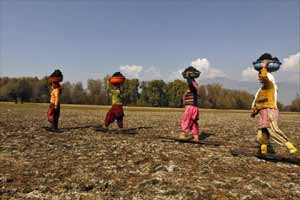It is a matter of serious concern that agricultural incomes are falling and there is a widespread farmers’ distress across different parts of India due to subsequent droughts, crop losses and inability to get remunerative market prices. Raising agricultural incomes mean increasing demand for manufacturing and service sectors, there by accelerating economic growth through bottom of the pyramid in rural areas. Agriculture at present is facing numerous challenges and adversely affecting farmers’ incomes. It is a paradox that when Indian economy is rated as the fastest-growing large economies, agricultural sector is performing very poorly.
The Budget shows a clear road map to protect farmers against various kinds of risks and increase agricultural incomes through irrigation development, improved soil health, access to markets, credit, and agricultural insurance. Agriculture is still confronted with the vagaries of monsoon. Irrigation development is very critical to cope-up the drought and make agriculture more resilient. Therefore, giving high priority to Pradhan Mantri Krishi Sichai Yojana will be a boon for the rain-fed and drought-affected farmers. Investment on water conservation, water harvesting, water management and groundwater development are the key components for irrigation development.
Improving soil health is necessary to increase crop yields and farm incomes. It is welcoming that 14 crores soil health cards will be distributed and 2000 retail outlets will be opened for seed and soil testing. However, it must be insured that farmers follow the recommended doses of nutrients to improve soil health. Soil testing must be supported by on-farm demonstrations on soil test based nutrient management.
The Budget has also provision to increase production of pulses. India is facing shortages of pulses and non-availability of pulses in global markets is causing persistent problem of rising and high price volatility. The provision has linked with the National Food Security Mission which is mandated for large-scale demonstrations. The budget of R500 crore must also be used for seed production, incentives to the states for producing more pulses and their contribution for environmental services. India must strive to be a leader in pulses production to meet the global requirement which is rising very fast in developed and many African countries.
Food processing is a sun rise sector. There are losses to the tune of 20-40% in the entire supply chain of various food commodities. These losses are much higher during peak supply of perishable commodities. Also, the demand for processed food is increasing with growing incomes and changing taste and preferences of consumers. A provision of 100% foreign direct investment will definitely bring global best practices and technologies in food processing and retailing.
The Budget has further committed for mitigating risk arising due to climatic/weather uncertainties. The low-premium high-coverage Pradhan Mantri Fasal Bima Yojana will compensate farmers during the odd years and minimize the farmers’ distress.
On reform, it is proposed to pilot direct benefit transfer of fertilizer subsidy in few districts. It is right time to gradually transfer fertilizer subsidy directly to the beneficiaries after successful accomplishment in case of cooking gas. Overall, the Budget is pro-farmer and agriculture.
The author is Director-South Asia, International Food Policy Research Institute, New Delhi


